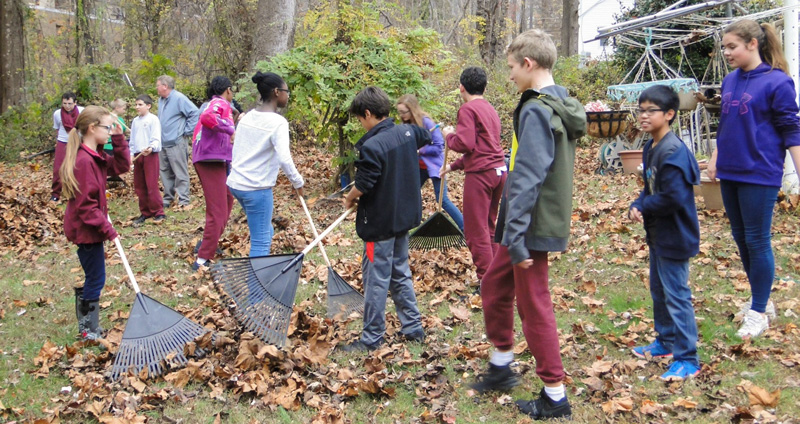
ARLINGTON, VA.—In his encyclical “Laudato Si’, on Care for Our Common Home,” Pope Francis does not mince words: “Living our vocation to be protectors of God’s handiwork is essential to a life of virtue; it is not an optional or a secondary aspect of our Christian experience.”
But what does living that vocation look like for Catholics and how can the faithful go beyond simply recycling bottles and newspapers at home and turning off lights?
A new guide draws from more than a dozen countries and cultures to offer practical ways to care for creation and respond to the pope’s call to action. The “Eco-Parish Guide: Bringing ‘Laudato Si’’ to Life” is a tool for pastors, staff, pastoral councils and parishioners to combat climate change — what Pope Francis refers to as “one of the principal challenges facing humanity in our day.”
Divided into three main sections, the guide includes initiatives that can help parishes reduce emissions, suggestions for how they can inspire and engage parishioners about environmental issues, and ways to practice solidarity and advocacy that serve the neediest and build up the common good.
It encourages parishes to form a Care for Creation Team, which spearheads projects with approval from the pastor; provides recommended resources; and contains a climate-action idea checklist. It also has a section on benchmarking — comparing energy performance of a church to buildings of comparable size and location — and certification.
Among the Catholic communities featured in the 45-page guide — available at bit.ly/Eco-ParishGuide — is St. Francis of Assisi Church in Triangle, Va., one of three parishes highlighted in North America.
St. Francis is noted for its certification through New Jersey-based GreenFaith, a national interfaith environmental coalition. The parish and school established nontoxic maintenance and cleaning practices; reduced energy, paper and water use; and became a National Wildlife Federation certified wildlife habitat.
They also incorporated Catholic social teaching on the environment into parish celebrations and engaged and informed parishioners on environmental justice.
While the certification process was ambitious, “every parish can do something to help the environment,” said Rob Goraieb, a secular Franciscan, who is coordinator of Franciscan Action and Advocacy at St. Francis of Assisi. “It’s about taking incremental steps; you do what you can,” he told the Arlington Catholic Herald, newspaper of the Diocese of Arlington.
Goraieb said he hopes his parish’s certification and other examples in the guide will “bring the big march for climate change into the pews — making it practical and tangible so that it grows into an effort of the heart, not the fist.”
Real change will occur he said, not through a “fight for climate change” but by transforming behavior informed by faith. “Our foundation has to be the Gospel,” he said. “We must operate out of that.”
The “Eco-Parish Guide” was created by the Global Catholic Climate Movement, a worldwide network of more than 300 Catholic organizations. Composed of laypeople, priests, religious, bishops and others, the Catholic movement was united by “the moral imperative of responding to and raising awareness about climate change,” according to the “Eco-Parish Guide.”
Lead author of the guide was Gail Kendall, a Massachusetts Institute of Technology-trained engineer with decades of experience in climate change work across the globe. Kendall said that with more than 220,000 Catholic parishes around the world, the Church can play an integral role in reducing greenhouse gas emissions.
To be useful to parishes worldwide, the guide reflects diversity, said Kendall.
One parish featured in the guide is St. Peter’s Church in Bandra, a suburb of Mumbai, India. Parishioners installed nearly 200 solar panels on the church terrace to power parish buildings.
The guide points out that many efforts to combat climate change can be implemented easily and for free. And some initiatives can save parishes as much as 20 percent to 30 percent in energy costs, according to the guide. More importantly, the document shows how climate change is directly related to poverty and other social justice issues, said Kendall. In “Laudato Si’,” the pope writes that “our relationship with nature is inseparable from fraternity, justice and faithfulness to others.”
Understanding such interconnectedness is part of the charism of the Franciscan order and thus interwoven into the spirit of St. Francis of Assisi Church, said Franciscan Father John F. O’Connor, temporary administrator of the parish.
“Very much part of what it means for all of us to be disciples of Jesus is to understand that we are responsible for cherishing, protecting and celebrating creation,” Father O’Connor said.
“The average person goes through life not thinking much about creation — maybe just thinking how nice the trees or the birds are,” he said. “But if we’re not careful with the beauty of the world around us, we could lose it.”
Katie Scott | Catholic News Service
CNS photo/courtesy St. Francis of Assisi Church: Students from St. Francis of Assisi School in Triangle, Va., rake leaves as part of a clean-up effort in 2015. St. Francis of Assisi Parish was certified as a “GreenFaith Sanctuary” in 2014 and is featured in a new guide to help Catholic parishes combat climate change.

